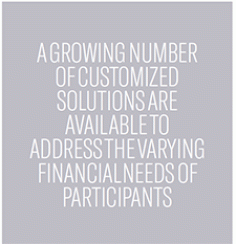To view a PDF of the report, click here.
New research and fresh insights are helping sponsors of qualified retirement plans address the key challenges facing their participants: increasing savings rates, constructing an appropriate portfolio and translating those assets into a steady income stream.
For sponsors of 401(k)s and other defined contribution (DC) plans, a growing number of customized solutions are available to address the varying financial needs of participants. Meanwhile, employers with defined benefit (DB) pension plans are weighing strategies to address their long-term liabilities while maintaining attractive benefits programs.
“Best practices for both DC and DB plan sponsors include transparency and vigilant risk management,” says Doug Kinney, Executive Vice President, Client Relations and Product Development, Bentall Kennedy, a Sun Life Investment Management Company. “Since DB plans closely monitor individual investments and already have a keen eye on these two practices, DC plans will need to continue to increase sophistication of oversight and diligence to achieve similar performance.”
In the DC sector, sponsors should take a careful look at the foundations of their plans, says Lorie Latham, Senior Defined Contribution Strategist, T. Rowe Price. “Every DC plan sponsor is unique. We encourage them to integrate design, governance, participant engagement and investment oversight in order to develop plans that align to objectives and best position participants for the most successful outcomes.”
Latham says sponsors should ask these basic questions: Is this a primary retirement vehicle for participants or a supplemental one? Is the goal to accumulate participants’ assets to retirement or take them into retirement? Do you want to retain retirees’ assets in the plan or disburse them? How does the DC plan fit into the organization’s total benefits program? How do you define risk, such as market volatility, inflation and longevity?
“Answering these questions brings greater clarity to the retirement planning process, and can lead to better decision-making for both sponsors and participants,” says Latham.
Examining the participant journey
From enrollment to asset accumulation, and to retirement and beyond, DC plan sponsors are looking more closely at every step of the participant journey and experience. “A big part of that is communications — knowing how to engage participants at the right time and place to encourage them to take action,” Latham says. “For example, Millennials contending with debt might require a different engagement profile than baby boomers entering into early retiree phase.”
As part of the change in communications, many sponsors are using modeling tools to help retirees translate their current balances into potential income streams — a step that could spur low savers into increasing their contributions.

Another best practice for many DC plans is providing plan participants with access to financial planners, including voice, video and face-to-face conversations. “There are so many individual variables in retirement planning,” says Austin. “For instance, does a participant also have access to a DB plan? Is she married or single? How many children does a participant have? All these factors impact a participant’s financial situation, so it’s difficult to have the same approach for everyone.”
Sponsors are also looking beyond a participant’s retirement to look at issues such as inflation and longevity risks. “In the past 16 years, we have seen increased concern over income, longevity and inflation risks,” says Wyatt Lee, Portfolio Panager, Retirement Date Strategies, T. Rowe Price. “That often means including growth assets in a retirement portfolio, rather than simply playing defense with conservative asset strategies. We know that retirement is not the end of the game, and higher equity allocations can help address those risks.”
New options in DC plan design
To meet their objectives, DC sponsors have a growing number of options in plan design. In the current low-yield environment, DC plan sponsors need to broaden their search for assets, says Kinney. Real estate is one option to consider, since it offers the possibility of capital appreciation as well as income, he adds.
Both sponsors and service providers are looking at ways to improve target date funds (TDFs) that offer a balanced asset allocation mix for participants. As a participant nears retirement age, the TDF’s glide path typically becomes more conservative with more fixed-income securities.
Today, there are more than 60 off-the-shelf TDF offerings, giving plan sponsors a much broader choice in terms of glide paths, asset class diversification, active versus passive strategies and bundled or custom products. “We have seen solid growth in both TDF assets and participant usage in the past decade, and this is likely to continue,” says Lee.
Lee says T. Rowe Price’s data shows that TDFs do improve asset allocations and outcomes. Individuals on their own tend to invest at the extremes, holding too much cash or all equities. He adds that TDFs are a behavioral solution to this investment problem, and lead to improved portfolio performance.
However, Austin cautions that even through TDFs are designed as an “all-in investment,” the company’s research shows that most participants include other types of assets in their portfolios. That indicates participants need more education on the role of TDFs.
In addition to educating participants, plan sponsors are taking a closer look at designing TDF glide paths, such as addressing risk tolerances and long-term investment goals. “Sponsors of large plans often cite their demographics as a reason to consider custom glide paths within TDFs,” says Jim Tzitzouris, Director of Asset Allocation Research, T. Rowe Price. “But other considerations should have an even stronger influence. Deciding on the appropriate percentage of equities is one of the key issues in shaping a glide path to achieve the desired retirement outcomes.”
Reflecting on the wide variety of options in DC design and structure, Latham says, “We don’t believe
there is a single right answer. Instead, sponsors can look at a solution
set that meets their participants’ specific needs.”
| Trends in Defined Benefit Plans Defined benefit (DB) plans are still an important sector of the retirement marketplace. In fact, a recent study by the National Institute on Retirement Security, "Pensionomics 2016," found that nearly $520 billion in pension benefits were paid to 24.3 million retired Americans in 2914. One of the key reasons employers in both the public and private sectors are shifting away from pensions is the difficulty in achieving sufficient returns from their investments to cover their future payouts to retirees. Fortunately, the strong post-election financial markets had a positive impact on their funding ratios. In its Pension Funding Index (PFI), which analyzes the 100 largest U.S. corporate pension plans, Milliman reported a $9 billion gain with an overall 81.6 percent funding status. Regardless of short-term financial results, many employers looking at "de-risking" strategies to take those pension plan liabilities off their books. "Lump sum windows were popular for several years, but employers realize their plans are at the mercy of individual decisions," says Rob Austin, Director of Retirement Research, Aon Hewitt. "Now, we are seeing a greater interest in settling their liabilities with annuity purchases through an insurance company. Our survey indicated about 28 percent of companies plan to purchase annuities this year. That’s about 10 percent higher than in the past few years.” |




